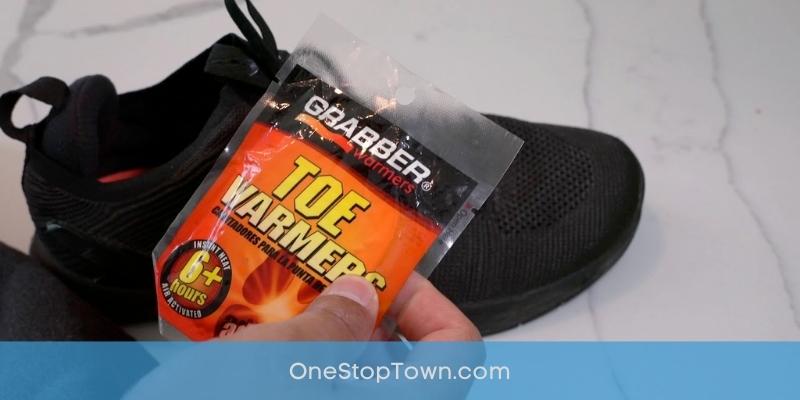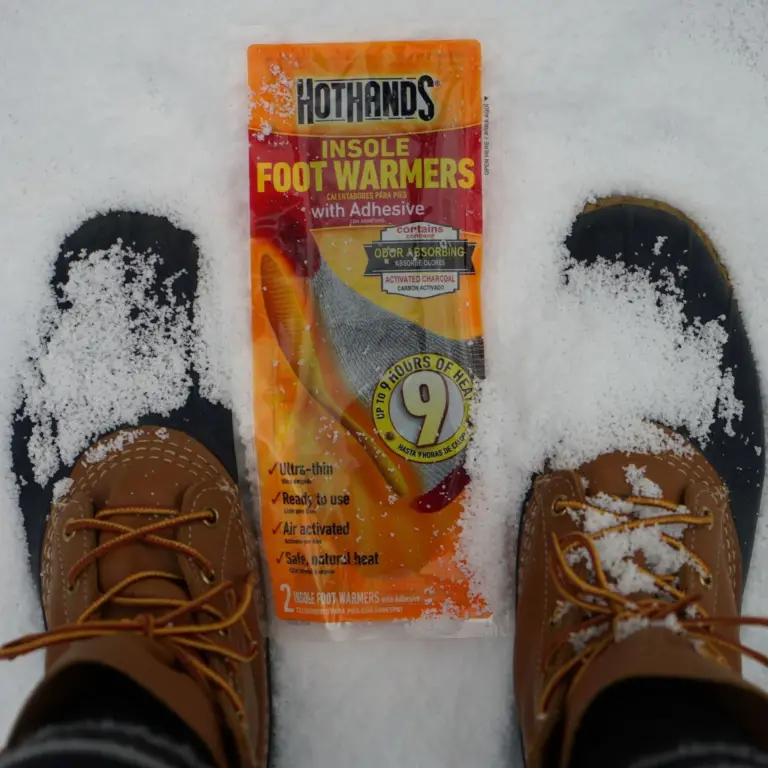Can You Put Hand Warmers in Your Shoes?

Yes, you can put hand warmers in your shoes, but there are a few things to keep in mind.
- Use the right type of hand warmer. There are two main types of hand warmers: chemical and electric. Chemical hand warmers are the most common type and are activated by exposure to oxygen. Electric hand warmers require batteries and can get quite hot. It is important to use the right type of hand warmer for your shoes, as electric hand warmers could melt or damage the shoes.
- Put the hand warmers in a safe place. You don’t want the hand warmers to come into direct contact with your skin, as they can get quite hot. It is best to put them in a pocket or sock inside your shoe.
- Be aware of the temperature. Hand warmers can get quite hot, so it is important to be aware of the temperature before you put them in your shoes. If you are sensitive to heat, you may want to start with a lower temperature setting.
- Replace the hand warmers when they get cold. Hand warmers will eventually cool down, so you will need to replace them every few hours.
If you follow these tips, you can safely use hand warmers in your shoes to keep your feet warm.
Here are some additional tips:
- If you are wearing boots, you can put the hand warmers in the toe area.
- If you are wearing shoes, you can put the hand warmers in the insole or the heel.
- You can also put hand warmers in your socks.
- If you are going to be wearing the shoes for a long period of time, you may want to bring an extra set of hand warmers.

Can I put hand warmers directly against my skin if I use them in my shoes?
No, you should not put hand warmers directly against your skin, even if you are using them in your shoes. Hand warmers can get quite hot, and direct skin contact can cause burns. The instructions on most hand warmers specifically state that they should not be placed in direct contact with the skin.
The best way to use hand warmers in your shoes is to put them in a pocket or sock inside your shoe. This will help to insulate the hand warmers and prevent them from getting too hot. You should also avoid putting hand warmers in shoes that are made of a breathable material, such as mesh or canvas. This is because the breathability of the material can allow the heat from the hand warmers to escape, which can increase the risk of burns.
If you are concerned about your feet getting cold, you can also try wearing thicker socks or using a pair of insulated boots. These measures will help to keep your feet warm without the need to use hand warmers directly against your skin.
Here are some additional safety tips for using hand warmers:
- Read the instructions carefully before using hand warmers.
- Do not use hand warmers if they are damaged or leaking.
- Keep hand warmers out of the reach of children.
- Do not use hand warmers in enclosed spaces, such as a car or sleeping bag.
- Remove hand warmers if they become too hot.
By following these safety tips, you can help to prevent burns and other injuries when using hand warmers.
What’s the optimal temperature setting for hand warmers in shoes?
The optimal temperature setting for hand warmers in shoes depends on a few factors, including your personal preference, the temperature outside, and the type of shoes you are wearing.
In general, a temperature setting of 100-110 degrees Fahrenheit is a good starting point. This is a warm but comfortable temperature that will help to keep your feet warm without getting too hot. If you are sensitive to heat, you may want to start with a lower temperature setting.
If you are wearing boots, you may need to use a higher temperature setting, as boots tend to be less breathable than shoes. Conversely, if you are wearing shoes, you may be able to get away with using a lower temperature setting.
You can also adjust the temperature setting of the hand warmers by wrapping them in a cloth or sock. This will help to insulate the hand warmers and prevent them from getting too hot.
It is important to check the temperature of the hand warmers regularly, especially if you are using them in a child’s shoes. If the hand warmers get too hot, remove them immediately.
How often should I replace hand warmers when using them in my shoes?
The frequency of hand warmer replacement depends on the type of hand warmer, the temperature setting, and the activity you are doing.
- Chemical hand warmers: Chemical hand warmers typically last for 4-12 hours. However, the exact duration will vary depending on the temperature setting. If you are using the hand warmers on a high setting, they will not last as long.
- Electric hand warmers: Electric hand warmers typically last for 6-8 hours. However, the exact duration will vary depending on the battery level.
If you are using hand warmers in your shoes, you should replace them every 2-3 hours. This will help to ensure that your feet stay warm and comfortable.
Are there any safety precautions I should take when using hand warmers in my shoes?
Yes, there are a few safety precautions you should take when using hand warmers in your shoes:
- Do not put hand warmers directly against your skin. Hand warmers can get quite hot, and direct skin contact can cause burns. The instructions on most hand warmers specifically state that they should not be placed in direct contact with the skin.
- Put the hand warmers in a safe place. You don’t want the hand warmers to come into contact with anything that could be damaged by heat, such as your clothing or other belongings. It is best to put them in a pocket or sock inside your shoe.
- Be aware of the temperature. Hand warmers can get quite hot, so it is important to be aware of the temperature before you put them in your shoes. If you are sensitive to heat, you may want to start with a lower temperature setting.
- Replace the hand warmers when they get cold. Hand warmers will eventually cool down, so you will need to replace them every few hours.
- Do not use hand warmers in enclosed spaces, such as a car or sleeping bag. The heat from the hand warmers can build up in enclosed spaces and cause a fire.
- Keep hand warmers out of the reach of children. Children are more likely to put hand warmers in their mouths, which can cause burns.
- Do not use hand warmers if they are damaged or leaking. Damaged or leaking hand warmers can cause burns.
By following these safety precautions, you can help to prevent burns and other injuries when using hand warmers.
Can I use hand warmers in both boots and regular shoes?
Yes, you can use hand warmers in both boots and regular shoes. However, there are a few things to keep in mind:
- Boots: Boots are typically more insulated than regular shoes, so you may need to use a lower temperature setting for the hand warmers. You also want to make sure that the hand warmers are not too big for the boot, as this could cause them to move around and possibly get lost.
- Regular shoes: Regular shoes are typically less insulated than boots, so you may need to use a higher temperature setting for the hand warmers. You also want to make sure that the hand warmers are not too big for the shoe, as this could cause them to move around and possibly rub against your skin.
It is also important to follow the safety precautions for using hand warmers, regardless of whether you are using them in boots or regular shoes.
Here are some additional tips for using hand warmers in boots and regular shoes:
- Put the hand warmers in a safe place. You don’t want the hand warmers to come into contact with anything that could be damaged by heat, such as your clothing or other belongings. It is best to put them in a pocket or sock inside your shoe.
- Be aware of the temperature. Hand warmers can get quite hot, so it is important to be aware of the temperature before you put them in your shoes. If you are sensitive to heat, you may want to start with a lower temperature setting.
- Replace the hand warmers when they get cold. Hand warmers will eventually cool down, so you will need to replace them every few hours.
By following these tips, you can help to keep your feet warm and comfortable while using hand warmers in both boots and regular shoes.
Are there any specific placement recommendations for hand warmers in different types of footwear?
Yes, there are some specific placement recommendations for hand warmers in different types of footwear:
- Boots: In boots, the best place to put hand warmers is in the toe area. This is because the toes are the most vulnerable to cold and can get cold the quickest. You can also put hand warmers in the heel area, but this is not as effective as putting them in the toe area.
- Regular shoes: In regular shoes, the best place to put hand warmers is in the insole. This is because the insole is in direct contact with your feet and will help to distribute the heat evenly. You can also put hand warmers in the heel area, but this is not as effective as putting them in the insole.
- Socks: You can also put hand warmers in your socks. This is a good option if you are wearing thin shoes or sandals.
It is important to experiment with different placement options to find what works best for you. You may also want to consider the type of hand warmer you are using. For example, chemical hand warmers can be bulky, so you may want to put them in a pocket or sock to keep them from moving around.
Resources
- https://theshoebuddy.com/can-you-put-hand-warmers-in-your-shoes/
- https://www.ems.com/how-to-use-hand-toe-warmers
- https://www.bikeforums.net/winter-cycling/612827-toe-hand-warmers.html
- https://www.advnture.com/how-to/use-hand-warmers
- How To Get Dog Poop Off Running Shoes?
- How To Clean Shoes With Fabric?
- How to Clean Your Bowling Shoes Slide Strip?
- Should Shoes Be A Little Tight?
- Are Vans Boat Shoes?
- Does StockX Sell Used Shoes?
- What Shoes Do Frogs Wear?
- Why Do Turtles Hit Black Shoes?
- How To Lace Dance Shoes?
- Can You Buy Shoes with Goat Credit?
- Do You Need To Break In New Running Shoes?
- What Is The Best Shoes For Nurses?
- Should Shoes Be A Little Big?
- What Is A Good Shoes For Plantar Fasciitis?
- How To Get Rid Of Squeaky Shoes?